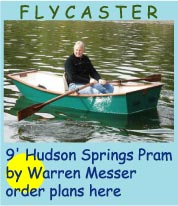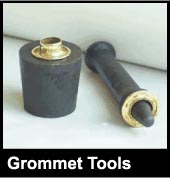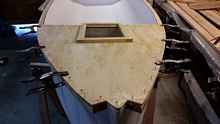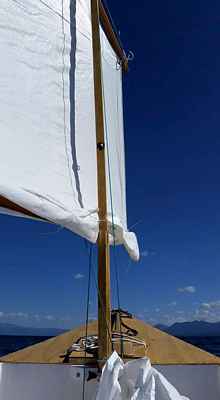
 Custom Search
|
| boat plans |
| canoe/kayak |
| electrical |
| epoxy/supplies |
| fasteners |
| gear |
| gift certificates |
| hardware |
| hatches/deckplates |
| media |
| paint/varnish |
| rope/line |
| rowing/sculling |
| sailmaking |
| sails |
| tools |
| join |
| home |
| indexes |
| classifieds |
| calendar |
| archives |
| about |
| links |
| Join Duckworks Get free newsletter CLICK HERE |
|
|
| A Michalak Mixer - Part One |
by Tom Geary
- Fremont, California - USA |
Part One - Part TwoWe have the amazing good luck to have access to a family cabin on Lake Tahoe. I’ve been coming here for several years with my wife, each summer I look out onto the water and wish I could go sailing. Last year (2014) I took the dream a little further, and got onto craigslist to see how much used sailboats cost. Answer: a lot. New sailboats – even something minimal like a Laser Pico – were serious money – $5k upwards. I’m not prepared to make payments on a toy. So I bought an inflatable raft to get my kids out on the water, then idly wondered whether I could fit a sail to it. To my surprise, you could. But the sail rig cost $1k. Browsing further through the forums, reading about modifications to Intex inflatables, it wasn’t long before I stumbled across people who’d built entire boats. Honestly, the idea seemed ridiculous. I browsed on. A few nights later, the idea had gestated in my head. I went looking for boats you could build yourself. I read about this boat called the PDRacer. It was quite universally slammed for being butt ugly, but utterly simple to build. I found Shorty’s site, read it all through, and decided to go for it. I am quite a project-oriented person. If I commit to something sensible, I’ll generally see it all the way through. I don’t always do a particularly good job, but I do finish. And so it was with the PDR. Almost every step along the way was a learning experience – from buying the plywood (heavy, and more expensive than I thought, and very tricky to transport) – to cutting the plywood (terrible job, uneven and wobbly) and every step in between. Still, I had fun, and the sense of having created something is awesome. Das Boot first sailed in some rather-too-windy conditions. It didn’t have decks or braces, it flexed quite badly, the leg-o-mutton sail couldn’t be reefed easily. I blasted up and down the lake for half an hour until my nerves were too jangled, then aimed back to shore. Later that month, I took Das Boot back to my garage and retrofitted it with decks, bracing, and epoxy taped seams. However, even as I was finishing the rebuild for Das Boot, I was hooked. I knew I was going to build something bigger and better. For one, I’m too cowardly to show up at a public boat ramp with a crooked, brown PDRacer. I’m too poor a sailor to pull that off. I needed a boat I could be proud of. The only successful boat is one that you use all the time. So after reading the duckworks plan catalog cover to cover, along with Bateau.com, Glen-L, and a few others, I made my decision. Almost. It was either going to be a Goat Island Skiff, or a Michalak Mixer. The tie-break was the size, my part of the garage (the minivan dominates, obviously) was only about 18 feet long. I have tool boxes, a beer fridge etc, that absolutely has to go somewhere. I doubt very much I could negotiate the relocation of the washer/drier. Sadly, the GIS was not to be. The Mixer it was! I Happen to like Mr Michalak’s philosophies. His plans are minimal, his aim is to design boats that get people out on the water with the minimum of fuss. No fancy work, no race-rigging, no traditional crap just for the sake of it. My aim was to create a boat that I could be proud of, that would sail me and my family safely around lakes at a minimum of cost. Michalak was my man.
Early on in the project I succumbed to the notion that I’d have to buy a trailer. I um’ed and ah’ed about it for a long while, but ultimately popped on the Harbor Freight Folding Trailer – about 300 bucks. The boat hangs a couple of feet off the back, but the whole rig fits in the aforementioned garage with room to spare for the beer fridge. I also accepted the idea that I’d have to register the boat with the California DMV. The idea of paying tax on a boat I’d made myself is almost enough to sign me up for the Tea Party, but rules are rules, and I dutifully took a 3 inch stack of receipts along. I had to wait for 90 minutes at the desk, while the DMV worker did all in her power to not have to deal with the amount of real work that I’d just dropped on her. However, a pleasant smile, impeccable manners and my innocent English accent convinced her to do her bloody job and figure this out. I walked out with boat and trailer both registered.
Building the boat started while my family were staying at the cabin. They get much more time off school than I get off work, so I generally leave them up there while getting on with my life down here in the bay area. I went to Home Depot, got 4 sheets of 5mm ply. That night I joined them together with epoxy and fiberglass butt joints to make 2 sheets 16 feet long. Marking out the lines was tough, I measured as carefully as I could, but still ballsed it up just about every station. Cutting with the circular saw, as per internet advice, was even harder – wobbly weavy lines abounded. My biggest mistake was in measuring and cutting the bilge panels. I wanted those big ply sheets gone before the family got home, so I skipped a few steps and tried to guess what size the bilges would be. It later turned out that they were completely incorrect and I had to chop them into smaller pieces and stitch them back together again. Another mistake was not adequately secure the forms before taping it all together. The hull is slightly crooked, one side bulges further than the other, and one corner is higher. Its hard to tell though. Another mistake I made was in reading too much about the details of taping seams. Some things really are better to try out for yourself. I’d read from the experts all sorts of advice, and tried to jump straight in. I found myself with a sticky pile of mess – badly laid fillets, tape that wasn’t straight, epoxy runs everywhere. I just built another boat (more on that later) and this time I used a pastry/icing bag (as my wife recommended months ago) and took it nice and easy – didn’t worry about getting three coats of epoxy on every sheet of plywood and doing everything all at once. Result – a much nicer finish. To be continued tomorrow... |
To comment on Duckworks articles, please visit one of the following:
|
 |







